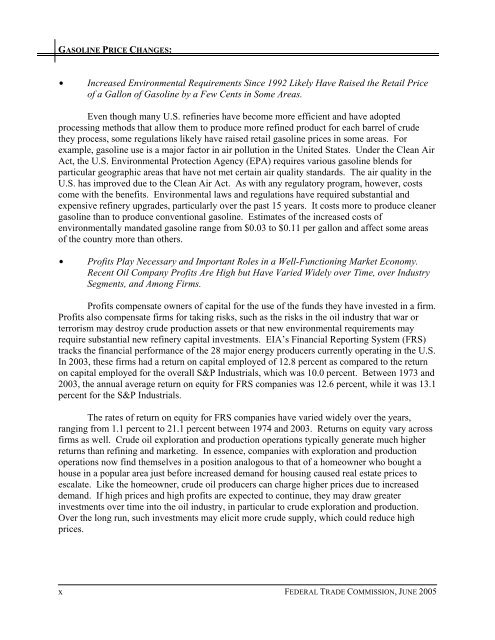Gasoline Price Changes - Federal Trade Commission
Gasoline Price Changes - Federal Trade Commission
Gasoline Price Changes - Federal Trade Commission
Create successful ePaper yourself
Turn your PDF publications into a flip-book with our unique Google optimized e-Paper software.
GASOLINE PRICE CHANGES:<br />
$ Increased Environmental Requirements Since 1992 Likely Have Raised the Retail <strong>Price</strong><br />
of a Gallon of <strong>Gasoline</strong> by a Few Cents in Some Areas.<br />
Even though many U.S. refineries have become more efficient and have adopted<br />
processing methods that allow them to produce more refined product for each barrel of crude<br />
they process, some regulations likely have raised retail gasoline prices in some areas. For<br />
example, gasoline use is a major factor in air pollution in the United States. Under the Clean Air<br />
Act, the U.S. Environmental Protection Agency (EPA) requires various gasoline blends for<br />
particular geographic areas that have not met certain air quality standards. The air quality in the<br />
U.S. has improved due to the Clean Air Act. As with any regulatory program, however, costs<br />
come with the benefits. Environmental laws and regulations have required substantial and<br />
expensive refinery upgrades, particularly over the past 15 years. It costs more to produce cleaner<br />
gasoline than to produce conventional gasoline. Estimates of the increased costs of<br />
environmentally mandated gasoline range from $0.03 to $0.11 per gallon and affect some areas<br />
of the country more than others.<br />
$ Profits Play Necessary and Important Roles in a Well-Functioning Market Economy.<br />
Recent Oil Company Profits Are High but Have Varied Widely over Time, over Industry<br />
Segments, and Among Firms.<br />
Profits compensate owners of capital for the use of the funds they have invested in a firm.<br />
Profits also compensate firms for taking risks, such as the risks in the oil industry that war or<br />
terrorism may destroy crude production assets or that new environmental requirements may<br />
require substantial new refinery capital investments. EIA’s Financial Reporting System (FRS)<br />
tracks the financial performance of the 28 major energy producers currently operating in the U.S.<br />
In 2003, these firms had a return on capital employed of 12.8 percent as compared to the return<br />
on capital employed for the overall S&P Industrials, which was 10.0 percent. Between 1973 and<br />
2003, the annual average return on equity for FRS companies was 12.6 percent, while it was 13.1<br />
percent for the S&P Industrials.<br />
The rates of return on equity for FRS companies have varied widely over the years,<br />
ranging from 1.1 percent to 21.1 percent between 1974 and 2003. Returns on equity vary across<br />
firms as well. Crude oil exploration and production operations typically generate much higher<br />
returns than refining and marketing. In essence, companies with exploration and production<br />
operations now find themselves in a position analogous to that of a homeowner who bought a<br />
house in a popular area just before increased demand for housing caused real estate prices to<br />
escalate. Like the homeowner, crude oil producers can charge higher prices due to increased<br />
demand. If high prices and high profits are expected to continue, they may draw greater<br />
investments over time into the oil industry, in particular to crude exploration and production.<br />
Over the long run, such investments may elicit more crude supply, which could reduce high<br />
prices.<br />
x<br />
FEDERAL TRADE COMMISSION, JUNE 2005
















